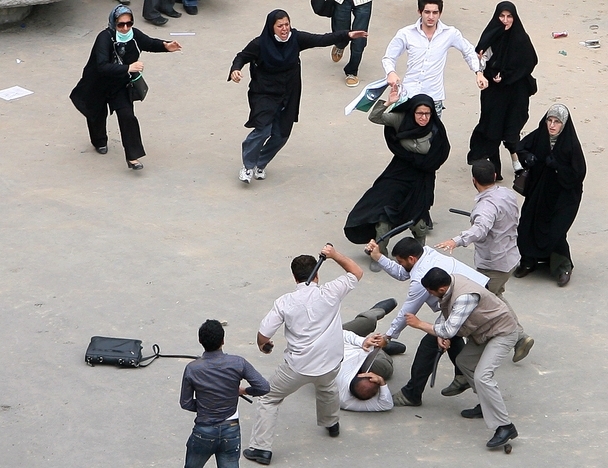
It's Independence Day in the United States... but in Iran,
some big news: the Association of Researchers and Teachers of Qom
has called the election and the Ahmadinejad government illegitimate.
This is a powerful group of leading clerics, so they'll be hard to shut up.
July 7, 2009
My friends Chris Lee and Meenakshi Roi are visiting Paris this
week on their way back home from
a bioinformatics conference in Stockholm. Today,
along with Lisa, we went down into the Paris Catacombs.
We met at Café Daguerre, where the pedestrian part of Rue Daguerre meets Avenue Géneral Leclerc, at 9:45 am. There's an entrance to the metro right here, so this is a great place to meet friends if you want to visit the catacombs. Walking due north one block along Géneral Leclerc and looking to our right, we spotted a long line of people waiting nearby at the entrance to the catacombs in Place Denfert-Rochereau.
The line slowly started moving around 10:00. Eventually we reached the front of the line, paid our 6 euros (or 4 euros with an academic discount) at the ticket counter, and descended a very long spiral staircase to the quarries below Paris. We then walked along twisting dim-lit corridors cut from the rock or lined with mortar, marching steadily for about 15 minutes, occasionally stopping to look at plaques, until we reached some rooms with sculptures of buildings, apparently made by a former prisoner who had committed these buildings to memory by staring out a jail window. This fellow later died in a cave-in.
Then the corridors widened out as we came to a doorway with a sign above it saying Arrete! C'est ici L'Empire de la Mort — "Stop! Here is the Empire of the Dead."
Heedless of this advice, we entered. Suddently we saw endless stacks of neatly packed bones, decorated by skulls. Leg bones formed the main front face of these structures.
Quoting the Wikipedia article:
Most of Paris's larger churches once had their own cemeteries, but city growth and generations of dead began to overwhelm them. From the late seventeenth century, Paris' largest Les Innocents cemetery (near the Les Halles district in the middle of the city) was saturated to a point where its neighbours were suffering from disease, due to contamination caused by improper burials, open mass graves, and earth charged with decomposing organic matter.Old stone plaques said which cemeteries each batch of skeletons was from, and when they'd been moved to the catacombs.After almost a century of ineffective decrees condemning the cemetery, it was finally decided to create three new large-scale suburban cemeteries and to condemn all existing within the city limits; the remains of all condemned cemeteries would be moved discreetly to a renovated section of Paris's abandoned quarries. The use of the depleted quarries for the storage of bones, based on the idea of Police Lieutenant General Alexandre Lenoir, was established in 1786 by his successor, M. Thiroux de Crosne, under the direction of Charles Axel Guillaumot, Inspector General of Quarries, and following him, by Louis-Étienne Héricart de Thury.
Remains from the cemetery of Saint-Nicolas-des-Champs were among the first to be moved. Bodies of the dead from the riots in the Place de l'Hôtel-de-Ville, the Hotel de Brienne, and Rue Meslee were put in the catacombs on 28 and 29 August 1788.
Some signs had poems on them, first in French, then in Latin as we reached more ancient regions.
I hadn't really understood how many people were down there until today. Someone said 6 million, but the impressive part is not the number, but actually hiking for almost an hour down dim-lit corridors lined with bones, skulls, plaques, poems and altars. I have little sense of how much of the whole labyrinth we saw — many passageways were blocked off, probably to keep people from getting lost.
Some regions were wet underfoot, with water dripping from the ceiling. For example, the region near the Crypt of the Sepulchural Lamp:
Towards the very end, we came to some large chambers had been formed by cave-ins. Here there was an exhibit about people killed during the Revolution the Terror, and the following violence who are now among the dead in the catacombs: Robespierre, for example, and the chemist Lavoisier.
Finally, we climbed a narrow spiral staircase with about 80 steps,
and popped out into a little white room with a doorway to a street
several blocks southeast of Place Denfert-Rochereau. This door
is unlabelled and quite unobtrusive — if I'd simply walked by it,
I'd never have guessed where it leads!
July 9, 2009
There was a big cyber attack on US and South Korean websites:
Earlier, when Lisa and I were staying at Rue Liancore, I'd walk down Boulevard August Blanqui to the Paris 7 math department at Chevralet, always in a hurry because I was always late, and I'd see the pretty ivy-covered wall where Rue des Cinq Diamants meets the avenue at a very acute angle, and I'd wonder "What's that street?" And then I'd see the street sign, almost overgrown with ivy: "Rue des Cinq Diamants". And I'd want to go down it, in part because it looked interesting and in part because the name "Street of Five Diamonds" seemed mysterious and romantic. But I was always in too much of a rush.
But now I had time to look around, and yes: it's romantic! But I can't find out why it's called "5 diamonds". If you know, please drop me a line.
I'm actually curious about a lot of the street names in Paris.
For example,
Rue du Vieux-Colombier. I guess this means "Street of
the Old Dovekeeper, which seems to hint at yet another romantic
tale.
July 14, 2009
Yesterday my fellow n-Café blogger
David
Corfield and his wife Ros showed up for a few day's
visit. They're staying at the Hotel St. Jacques on Rue
des Ecoles, which is just a couple blocks north of here.
They spent a year once on Rue Vallette, just north of the
Pantheon, so this area is like an old home to them.
But, they didn't know our favorite restaurant right near
the Pantheon - L'Écurie, on Rue Laplace. So, we
ate there last night.
I'd hoped to have a nice conversation with both David and Paul-André Melliès, but Paul-André couldn't make it, so I wound up talking to David for hours and hours.
Bastille Day!
July 15, 2009
I spent a long time telling David about my project with James
Dolan on algebraic geometry. It was fun getting a chance to explain
the whole thing, or at least a large portion. I haven't talked about
it much with anyone except Jim. I've discussed it with David and others on the
n-Café, and that served as a nice
springboard for the conversation, but I think we got a lot further today.
Talking is a good way to prepare for writing an expository paper.
July 16, 2009
Hey! You can hear all of Bill Frisell's new album on National Public
Radio!
For example: the tiger moth, Bertholdia trigona, defends itself by jamming the sonar of bats! You can hear it doing so on this radio show:
Two researchers have shown a striking example of endosymbiosis forming now: in 2005 Noriko Okamoto and Isao Inouye reported on a unicellular organism called Hatena. Hatena ("enigma" in Japanese) leads a curious life cycle. Hatena is a single-celled organism, swimming around in the water, using a little feeding apparatus to eat cells and organic material smaller than itself. At some point, it would feed on a unicellular alga, the Nephroselmis. Once Hatena swallows Nephroselmis, it does not digest it. Rather, Nephrosolmis makes itself a comfortable home inside Hatena. The alga starts growing inside Hatena: it grows to about 10 times its original size, filling up most of Hatena. The alga also seems to lose most of its own organelles, except for the chloroplast. The chloroplast actually grows bigger.What happens in the next generation? Read the blog article!

Hatena before and after ingesting Nephroselmis.
Picture by Noriko Okamoto.Hatena changes too as a result. Before ingesting the alga, it has a rather complex "mouth", or feeding apparatus. After ingesting the alga, this mouth disappears only to be replaced by an eyespot from the alga. The eyespot is a light sensing organelle, a very primitive eye, that guides algae to light sources. In this case, it also guides the host, Hatena, to light. Hatena has obviously stopped feeding, at least through its mouth. It is now swimming to the light, letting the alga photosynthesize its food for both of them.
Why does the article by Okamoto and Inouye speak of "secondary
symbiosis"? Because algae themselves acquired the ability
to phosynthesize by symbiosis! Billions of years ago they took
in cyanobacteria,
which gradually lost the ability to live on their own and
became chloroplasts.
July 21, 2009
Physicists like to complain that economists don't make enough testable
predictions. There's a geophysicist at UCLA named Didier
Sornette who has tried to remedy this situation. Here is his latest
paper on the arXiv:
You can watch how it does on Yahoo. It's interesting how the graph looks so different depending on which time scale you view it at.
For more, try:
For a sketchy but readable explanation of Sornette's model, leading up to his "log-periodic power law", try this:

For dinner I had just salad, bread and cheese. But oh, what cheese! It's a kind called Eschourgnac. We were introduced to it by one of the daughters of our friend Anne Cheng, a young gourmet who described meeting this cheese as a case of "love at first bite". That was exactly my reaction, too.
It has an intense smell and taste of walnuts, obtained by
washing the rind in walnut liquer. Somehow that taste permeates
the whole cheese, and it's delicious. It's been made since 1868,
first by monks in la Trappe d'Echourgnac, and then, after an
interruption in World War I, by Cistercian nuns.
July 23, 2009
A friend pointed me to this article:
The ideals of the reform movement have now been destroyed. Its impractical ideas of freedom, tolerance and civil society failed to attract support among the ordinary people who wanted social justice and an end to poverty. - Iranian government newspaper
© 2009 John Baez
baez@math.removethis.ucr.andthis.edu